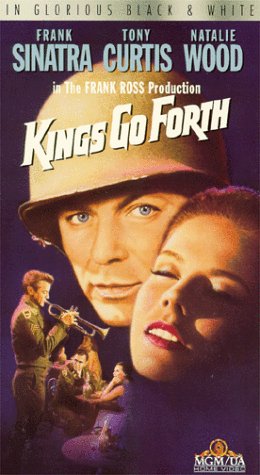
KINGS GO FORTH
US, 1958, 109 minutes, Black and white.
Frank Sinatra, Tony Curtis, Natalie Wood, Leora Dana.
Directed by Delmer Daves.
Kings Go Forth is a story of the invasion of southern France by the Americans during World War Two. While many films portray the Normandy invasion or battles in Italy as well as the ending of the war in north-eastern France with the Battle of the Bulge, this is a different focus.
The film is directed by Delmer Daves, a writer-director who began with a war film in 1943: Destination Tokyo. He also made The Pride of the Marines. He made the breakthrough western, Broken Arrow, in 1950 with the focus on more respect for native American Indians. After a number of adventure films including Demetrius and the Gladiators, he made a number of westerns in the mid-50s: Drum Beat, Jubal, The Last Wagon, 3.10 to Yuma, Cowboy. He then made Kings Go Forth and followed it with more westerns: The Badlanders and The Hanging Tree. His final films, made from 1959 to 1965, were lush romantic melodramas including Parrish, A Summer Place, Susan Slade, Youngblood Hawk and The Battle of the Villa Fiorita.
The film is a star vehicle for Frank Sinatra, not glamorising him as the popular singer, but presenting him as a straightforward military character. He is involved with a young Natalie Wood who was emerging from juvenile roles to adult roles at this period: Rebel Without a Cause, The Searchers. His rival is a spoilt young American, played by Tony Curtis. Curtis had just appeared in The Sweet Smell of Success and was to be paired with Sidney Poitier in The Defiant Ones. He was making a transition from popular matinee idol in a lot of Universal and International colourful adventures to a more serious actor.
The film is not so well known – but is an interesting take on World War Two from the period of the 50s and the reassessment of war action as well as tribute to it at that time.
1. The impact of this film as a war film, romance film? The significance and meaning of the title?
2. Consider the film as a film of the fifties. Would it be made similarly now?
3. The presentation of the war situation and our understanding of it: the opening and the soldiers, the French reception, the changes in character for soldiers, away from home, crises, men not themselves, emotional crises. loneliness?
4. The insight into war via the battle sequences, their presentation at the end, the strategy and tactics, the visual context for the emotional conflicts?
5. The importance of the French setting, the tradition of France for love and emotions?
6. How engaging a hero was Sam? Frank Sinatra’s style, Sam as a hero, lonely, the attraction towards Monique, Mrs Blair and her encounter with Sam, the truth about the black ancestry. Sam’s capacity for love, for being hurt, for wanting to kill Britt? Was he a convincing character and personality?
7, The contrast with Britt? Sam liking him, his playing with Monique’s affections, the background and his being spoilt, the "cad" aspect of his personality, his heroism? how convincing, especially in his death?
8. Monique as an attractive heroine? Her French background, the American background, her reluctance to be involved with Sam, her capacity for love, attraction towards Britt, being hurt, the reason for her suicide attempt? Meeting her at the end and growing vitality?
9. Mrs Blair and the picturing of her dignity? Her love for Monique? Her husband? Sam?
10. How well presented was the race theme? Convincing?
11. The drama of the men with the war sequences and Britt’s death? Appropriate for this kind of film?
12. Was the film successful as a war drama and as a romantic drama?